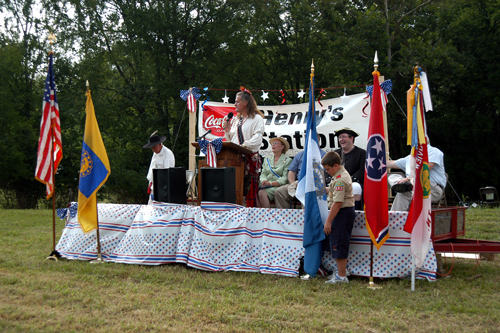

O-Si-Yo!
One of the goals of the Henry Station Foundation is to create and maintain a Cherokee farmstead of the 1780-1796 time period. Why do that? What does a Cherokee farm have to do with Sevier County? There was no such farm on this property. I’ll give you three reasons. Education, education, education. That is why. Let me give you a little background.
In 1738, a smallpox epidemic struck the Cherokee nation. No town in any region was spared. The epidemic ran its course in about 18 months. During this short period of time, approximately half of the Cherokee people died. Of a population of 20,000 men, women, and children, only 10,000 survived.
Imagine losing half of your family, half of your town, half of your clan, half of your nation, in only 18 months. More epidemics on a smaller scale occurred in the ensuing years, but somehow the Cherokee population remained stable – about 9,000 at the time Hugh Henry arrived in this area, as the Revolutionary War was drawing to a close. In 1783, the same year the American Revolution ended, the North Carolina General Assembly designated the area of the French Broad, Holston, and Big Pigeon Rivers as Cherokee hunting grounds where, “No white man shall enter.” That did not stop white settlers from illegally moving into this area.
As you know, Major Henry was an American officer during the Revolutionary War, a war in which the Cherokee sided with the British. Once the war ended, the Americans retaliated against the Cherokees. Approximately 50 Cherokee towns were destroyed – completely destroyed. Houses were burned. Cornfields were burned. Livestock was scattered. The people were killed, scattered, or captured and sold into slavery. Understandably the Cherokee had little choice but to sign a peace treaty with the United States.
Prior to 1785 when the Treaty of Dumplin Creek was signed here, the Cherokees had made ten land cessions with South Carolina, North Carolina, Georgia, Virginia, the British Superintendent of Indian Affairs, and the Transylvania Land Company. These cessions totaled 43 million, 776 thousand acres. That’s 68,400 square miles. If that territory were a state today, it would rank as the 17th largest in the country. Tennessee, by the way, has 41,219 square miles and ranks 34th in size!
The Treaty of Dumplin Creek was signed here on June 10, 1785. Thirty Cherokee headmen and warriors were on hand. Representing the white settlers and the State of Franklin was John Sevier, who had led some of those attacks on Cherokee towns earlier. This treaty made it possible for Sevier, Knox, and Blount Counties to be settled without resistance from the Cherokees. As the treaty reads, “…the white people shall never be by us, or any of our Nation, molested or interrupted, either in their persons or property, in no wise or in any manner or form whatsoever, in consequence of their settling or inhabiting of said territory…”
The whites understood this to mean that settlers could freely and safely move into this area. The Cherokee saw it differently. In November of that same year, 1785, the Cherokee met with representatives of the United States to complain that their intention with the Dumplin Creek Treaty was simply to allow those settlers who were already illegally on their land to remain. It was not meant that more settlers would be allowed into the area. The United States, as North Carolina had done previously, did not accept the Dumplin Creek Treaty, and negotiated a new agreement, the Hopewell Treaty, with the Cherokees. According to this new treaty, the land opened by the Dumplin Treaty would be returned to the Cherokees and they would have the right to punish any white person who chose not to move.
This Hopewell Treaty would be the first the United States entered into with an Indian nation. It would be the first time the Cherokee signed a treaty with the United States, but certainly not the last. A total of 24 land cession treaties would be signed with the new country. In those cessions, the Cherokee relinquished another 24 million, 144 thousand, 560 acres; that is 102 thousand, 667 additional square miles. If that territory, not including what was ceded prior to 1785, were a state today it would rank as the 9th largest, much larger than the state of Tennessee, which ranks 34th!
Today the Cherokee control only the 56,000 acres of the Qualla Boundary, Cherokee, North Carolina. Only a fraction of the size of Sevier County.
It is understandable that even today the Cherokee people are interested in treaty rights and maintaining the sovereignty of the Cherokee nation. And that means knowing the history of the people. Just last week, Michell Hicks, Principal Chief of the Eastern Band of the Cherokee Nation, emphasized the importance of studying history. It is important, the chief said, for the survival of the people. One must know history to preserve it and to protect sovereignty. “Forgetting history is the first step to losing sovereignty,” he said.
Today I urge you to join with us as we tell not only an accurate story of what happened here, but a complete story as well.
Wado!